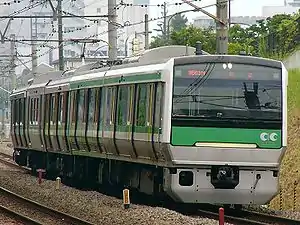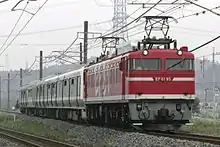E993 series
The E993 series (E993系) "AC Train" was an experimental 5-car electric multiple unit (EMU) train operated by East Japan Railway Company (JR East) in Japan between 2002 and 2006.[1][2]
| E993 series | |
|---|---|
 E993 series train on test, June 2004 | |
| In service | 2002–2006 |
| Manufacturer | Kawasaki Heavy Industries, Tokyu Car Corporation |
| Constructed | 2002 |
| Scrapped | 2006 |
| Number built | 5 vehicles (1 set) |
| Formation | 5 cars per set |
| Capacity | Non-passenger |
| Operator(s) | JR East |
| Depot(s) | Kawagoe |
| Specifications | |
| Car body construction | Stainless steel |
| Car length | 16,050 mm (52 ft 8 in) (end cars), 13,000 mm (42 ft 8 in) (intermediate cars) |
| Width | 3,000 mm (9 ft 10 in) |
| Height | 3,640 mm (11 ft 11 in) |
| Floor height | 1,150 mm (3 ft 9 in) |
| Doors | 3 pairs per side 2 pairs per side (SaHa E993) |
| Maximum speed | 120 km/h (75 mph) |
| Power output | 200kW x2 per motor car |
| Electric system(s) | 1,500 V DC |
| Current collection method | Overhead catenary |
| Safety system(s) | ATC, ATS-P, ATS-SN |
| Track gauge | 1,067 mm (3 ft 6 in) |
Concept
The E993 series "AC Train" ("Advanced Commuter Train") was developed by JR East to test and evaluate a number of new technologies and features for possible use in future commuter train designs.[1] These included features intended to reduce life-cycle costs, improve the interior passenger environment, improve accessibility, and increase environmental friendliness.[2]
Technological features
The train incorporated the following features for evaluation.[2]
- Articulated cars with shared bogies
- Direct drive motors (DDM)
- Double-skin body construction
- Externally slung sliding doors
- Advanced Train Information Management System (AIMS)
Formation
The 5-car articulated set was based at Kawagoe Depot on the Kawagoe Line and formed as shown below, with car 1 at the Kawagoe end, and car 5 at the Shinjuku end.[3] Cars 1 and 2 were built by Kawasaki Heavy Industries in Kobe, and cars 3 to 5 were built by Tokyu Car Corporation in Yokohama.[2]
| Car No. | 1 | 2 | 3 | 4 | 5 |
|---|---|---|---|---|---|
| Designation | Tc' | M' | M | T | Tc |
| Numbering | KuHa E992-1 | MoHa E992-1 | MoHa E993-1 | SaHa E993-1 | KuHa E993-1 |
Cars 2 and 4 were each fitted with one single-arm pantograph.[3]
Cars 1 and 2 had double-skin aluminium bodies, cars 3 to 5 had stainless steel bodies with double-skin construction used for cars 3 and 5.[2]
 KuHa E992-1
KuHa E992-1 MoHa E992-1
MoHa E992-1 MoHa E993-1
MoHa E993-1 SaHa E993-1
SaHa E993-1 KuHa E993-1
KuHa E993-1
History

The train was delivered to JR East's Kawagoe Depot on 17 January 2002.[2] Test running commenced on the Kawagoe Line and Saikyo Line the following month.[2]
The train was officially withdrawn on 14 July 2006.[4] No cars are preserved.
Features tested on the E993 series, including articulated cars and direct drive motors, were subsequently incorporated in the E331 series prototype train delivered in 2006.
References
| Wikimedia Commons has media related to E993 series. |
- JR全車輌ハンドブック2005 [JR Rolling Stock Handbook 2005]. Japan: Neko Publishing. August 2005. p. 374. ISBN 978-4-7770-0382-2.
- プロトタイプの世界 - Prototype World. Japan: Kōtsū Shimbunsha. December 2005. pp. 76–79.
- JR電車編成表 '05冬号 [JR EMU Formations - Winter 2005]. Japan: JRR. January 2005. p. 66. ISBN 978-4-88283-042-9.
- "JRグループ車両のデータバンク2006/2007" [JR Group Databank 2006/2007]. Japan Railfan Magazine. 47 (555): Appendix p.37. July 2007.